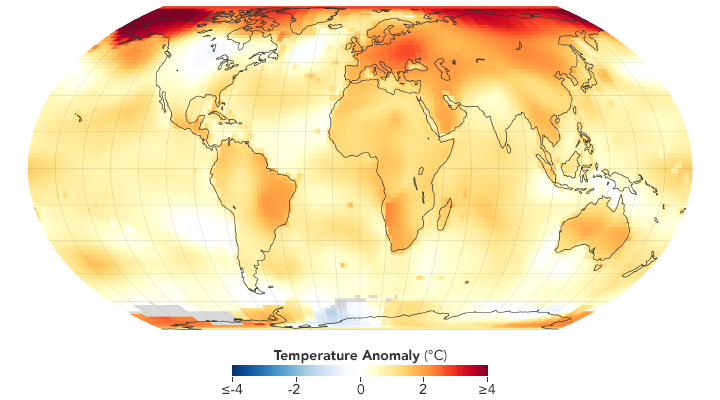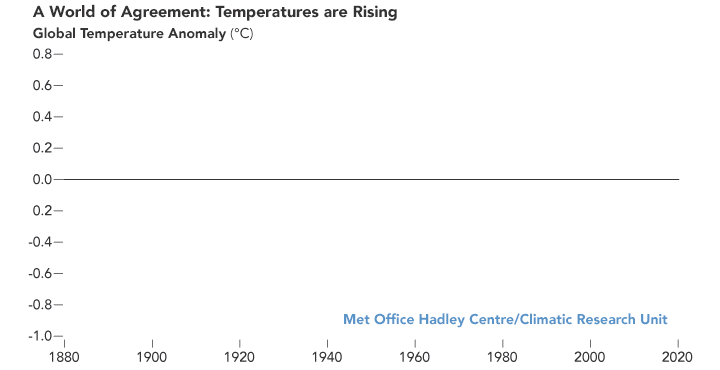2019 Was the Second Warmest Year on Record.
In 2019, global temperatures were 0.98 degrees Celsius (1.8 degrees Fahrenheit) warmer than the 1951 to 1980 mean, according to scientists at NASA’s
Goddard Institute for Space Studies. The map above depicts global temperature anomalies in 2019. It does not show absolute temperatures; instead, it shows how much warmer or cooler each region of Earth was compared to that baseline average.
“The decade that just ended is clearly the warmest decade on record,” said GISS director Gavin Schmidt. “Every decade since the 1960s clearly has been warmer than the one before.”
The animated plot below shows yearly temperature anomalies from 1880 to 2019 with respect to the 1981-2000 mean, as recorded by NASA, NOAA, the Berkeley Earthresearch group, the Met Office Hadley Centre (UK), and the Cowtan and Way analysis. Though there are minor variations from year to year, all five temperature records show peaks and valleys in sync with each other. All show rapid warming in. the past few decades, and all show that the past decade has been the warmest.
Since the 1880s, the average global surface temperature has risen more than 1 degree Celsius (2 degrees Fahrenheit) above the late 19th century. For reference, the last Ice Age was about 5.5 degrees Celsius (10 degrees Fahrenheit) colder than pre-industrial temperatures.
Using climate models and statistical analysis of global temperature data, scientists have concluded that this increase mostly has been driven by increased emissions into the atmosphere of carbon dioxide and other greenhouse gases produced by human activities.
“We crossed over into more than 2 degrees Fahrenheit warming territory in 2015 and we are unlikely to go back,” Schmidt said. “This shows that what’s happening is persistent, not a fluke due to some weather phenomenon. We know that the long-term trends are being driven by the increasing levels of greenhouse gases in the atmosphere.”
Because weather station locations and measurement practices change over time, the interpretation of specific year-to-year global mean temperature differences has some uncertainties. Taking this into account, NASA estimates that the global mean
change in 2019 is accurate to within 0.1 degrees Fahrenheit, with a 95 percent certainty level.
Weather dynamics often affect regional temperatures, so not every region on Earth experienced similar amounts of warming. NOAA found the 2019 annual mean temperature for the contiguous 48 United States was the 34th warmest on record, giving it a “warmer than average” classification.
The Arctic has warmed three times faster than the rest of the planet since 1970. Rising temperatures in the atmosphere and ocean are contributing to the continued mass loss from Greenland and Antarctica and to increases in some extreme events, such as heat waves, wildfires, and intense precipitation.
NASA’s temperature analyses incorporate surface temperature measurements from more than 20,000 weather stations, ship- and buoy-based observations of sea surface temperatures, and temperature measurements from Antarctic research stations. These in situ measurements are analyzed using an algorithm that considers the varied spacing of temperature stations around the globe and urban.
heat island effects that could skew the conclusions. These calculations produce the global average temperature deviations from the baseline period of 1951 to 1980.
NOAA scientists used much of the same raw temperature data, but with a different interpolation into the Earth’s polar and other data-poor regions. The NOAA analysis found 2019 global temperatures were 0.95 degrees Celsius...
(1.7 degrees Fahrenheit) above the 20th century average.
NASA’s full 2019 surface temperature data set and the complete methodology used for the temperature calculation and its uncertainties are available here.
NASA Earth Observatory images by Joshua Stevens, using data courtesy of Gavin Schmidt/NASA and the Goddard Institute for Space Studies. Story by Maria-Jose Vinas Garcia, NASA Earth Science News Team.


No comments:
Post a Comment